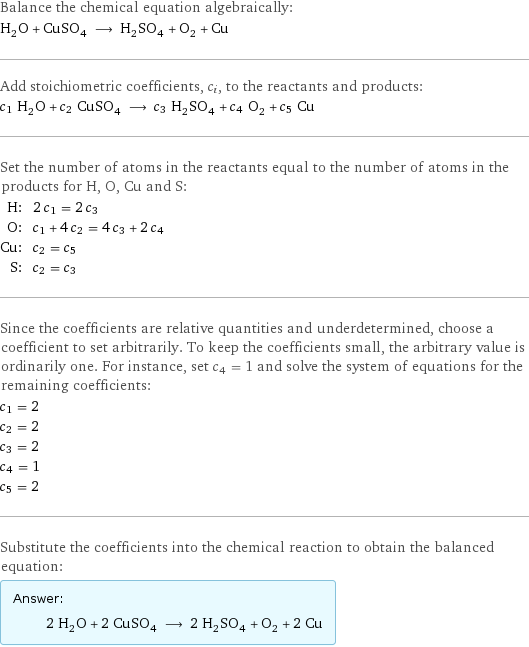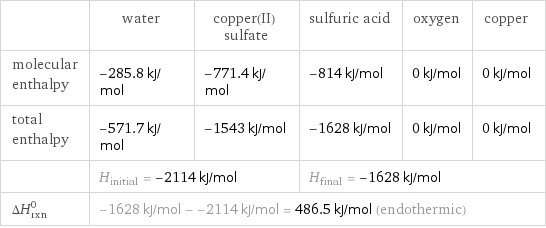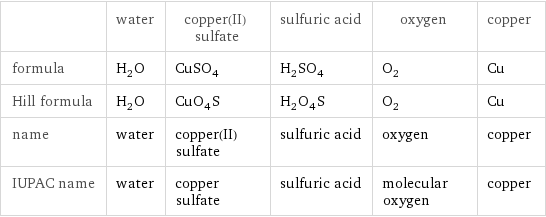Input interpretation

H_2O water + CuSO_4 copper(II) sulfate ⟶ H_2SO_4 sulfuric acid + O_2 oxygen + Cu copper
Balanced equation

Balance the chemical equation algebraically: H_2O + CuSO_4 ⟶ H_2SO_4 + O_2 + Cu Add stoichiometric coefficients, c_i, to the reactants and products: c_1 H_2O + c_2 CuSO_4 ⟶ c_3 H_2SO_4 + c_4 O_2 + c_5 Cu Set the number of atoms in the reactants equal to the number of atoms in the products for H, O, Cu and S: H: | 2 c_1 = 2 c_3 O: | c_1 + 4 c_2 = 4 c_3 + 2 c_4 Cu: | c_2 = c_5 S: | c_2 = c_3 Since the coefficients are relative quantities and underdetermined, choose a coefficient to set arbitrarily. To keep the coefficients small, the arbitrary value is ordinarily one. For instance, set c_4 = 1 and solve the system of equations for the remaining coefficients: c_1 = 2 c_2 = 2 c_3 = 2 c_4 = 1 c_5 = 2 Substitute the coefficients into the chemical reaction to obtain the balanced equation: Answer: | | 2 H_2O + 2 CuSO_4 ⟶ 2 H_2SO_4 + O_2 + 2 Cu
Structures

+ ⟶ + +
Names

water + copper(II) sulfate ⟶ sulfuric acid + oxygen + copper
Reaction thermodynamics
Enthalpy

| water | copper(II) sulfate | sulfuric acid | oxygen | copper molecular enthalpy | -285.8 kJ/mol | -771.4 kJ/mol | -814 kJ/mol | 0 kJ/mol | 0 kJ/mol total enthalpy | -571.7 kJ/mol | -1543 kJ/mol | -1628 kJ/mol | 0 kJ/mol | 0 kJ/mol | H_initial = -2114 kJ/mol | | H_final = -1628 kJ/mol | | ΔH_rxn^0 | -1628 kJ/mol - -2114 kJ/mol = 486.5 kJ/mol (endothermic) | | | |
Equilibrium constant
![Construct the equilibrium constant, K, expression for: H_2O + CuSO_4 ⟶ H_2SO_4 + O_2 + Cu Plan: • Balance the chemical equation. • Determine the stoichiometric numbers. • Assemble the activity expression for each chemical species. • Use the activity expressions to build the equilibrium constant expression. Write the balanced chemical equation: 2 H_2O + 2 CuSO_4 ⟶ 2 H_2SO_4 + O_2 + 2 Cu Assign stoichiometric numbers, ν_i, using the stoichiometric coefficients, c_i, from the balanced chemical equation in the following manner: ν_i = -c_i for reactants and ν_i = c_i for products: chemical species | c_i | ν_i H_2O | 2 | -2 CuSO_4 | 2 | -2 H_2SO_4 | 2 | 2 O_2 | 1 | 1 Cu | 2 | 2 Assemble the activity expressions accounting for the state of matter and ν_i: chemical species | c_i | ν_i | activity expression H_2O | 2 | -2 | ([H2O])^(-2) CuSO_4 | 2 | -2 | ([CuSO4])^(-2) H_2SO_4 | 2 | 2 | ([H2SO4])^2 O_2 | 1 | 1 | [O2] Cu | 2 | 2 | ([Cu])^2 The equilibrium constant symbol in the concentration basis is: K_c Mulitply the activity expressions to arrive at the K_c expression: Answer: | | K_c = ([H2O])^(-2) ([CuSO4])^(-2) ([H2SO4])^2 [O2] ([Cu])^2 = (([H2SO4])^2 [O2] ([Cu])^2)/(([H2O])^2 ([CuSO4])^2)](../image_source/f5b7808ec35e4031ae938a666283f2d2.png)
Construct the equilibrium constant, K, expression for: H_2O + CuSO_4 ⟶ H_2SO_4 + O_2 + Cu Plan: • Balance the chemical equation. • Determine the stoichiometric numbers. • Assemble the activity expression for each chemical species. • Use the activity expressions to build the equilibrium constant expression. Write the balanced chemical equation: 2 H_2O + 2 CuSO_4 ⟶ 2 H_2SO_4 + O_2 + 2 Cu Assign stoichiometric numbers, ν_i, using the stoichiometric coefficients, c_i, from the balanced chemical equation in the following manner: ν_i = -c_i for reactants and ν_i = c_i for products: chemical species | c_i | ν_i H_2O | 2 | -2 CuSO_4 | 2 | -2 H_2SO_4 | 2 | 2 O_2 | 1 | 1 Cu | 2 | 2 Assemble the activity expressions accounting for the state of matter and ν_i: chemical species | c_i | ν_i | activity expression H_2O | 2 | -2 | ([H2O])^(-2) CuSO_4 | 2 | -2 | ([CuSO4])^(-2) H_2SO_4 | 2 | 2 | ([H2SO4])^2 O_2 | 1 | 1 | [O2] Cu | 2 | 2 | ([Cu])^2 The equilibrium constant symbol in the concentration basis is: K_c Mulitply the activity expressions to arrive at the K_c expression: Answer: | | K_c = ([H2O])^(-2) ([CuSO4])^(-2) ([H2SO4])^2 [O2] ([Cu])^2 = (([H2SO4])^2 [O2] ([Cu])^2)/(([H2O])^2 ([CuSO4])^2)
Rate of reaction
![Construct the rate of reaction expression for: H_2O + CuSO_4 ⟶ H_2SO_4 + O_2 + Cu Plan: • Balance the chemical equation. • Determine the stoichiometric numbers. • Assemble the rate term for each chemical species. • Write the rate of reaction expression. Write the balanced chemical equation: 2 H_2O + 2 CuSO_4 ⟶ 2 H_2SO_4 + O_2 + 2 Cu Assign stoichiometric numbers, ν_i, using the stoichiometric coefficients, c_i, from the balanced chemical equation in the following manner: ν_i = -c_i for reactants and ν_i = c_i for products: chemical species | c_i | ν_i H_2O | 2 | -2 CuSO_4 | 2 | -2 H_2SO_4 | 2 | 2 O_2 | 1 | 1 Cu | 2 | 2 The rate term for each chemical species, B_i, is 1/ν_i(Δ[B_i])/(Δt) where [B_i] is the amount concentration and t is time: chemical species | c_i | ν_i | rate term H_2O | 2 | -2 | -1/2 (Δ[H2O])/(Δt) CuSO_4 | 2 | -2 | -1/2 (Δ[CuSO4])/(Δt) H_2SO_4 | 2 | 2 | 1/2 (Δ[H2SO4])/(Δt) O_2 | 1 | 1 | (Δ[O2])/(Δt) Cu | 2 | 2 | 1/2 (Δ[Cu])/(Δt) (for infinitesimal rate of change, replace Δ with d) Set the rate terms equal to each other to arrive at the rate expression: Answer: | | rate = -1/2 (Δ[H2O])/(Δt) = -1/2 (Δ[CuSO4])/(Δt) = 1/2 (Δ[H2SO4])/(Δt) = (Δ[O2])/(Δt) = 1/2 (Δ[Cu])/(Δt) (assuming constant volume and no accumulation of intermediates or side products)](../image_source/6160e11fafaf9e6d3ff89b6142f56a3a.png)
Construct the rate of reaction expression for: H_2O + CuSO_4 ⟶ H_2SO_4 + O_2 + Cu Plan: • Balance the chemical equation. • Determine the stoichiometric numbers. • Assemble the rate term for each chemical species. • Write the rate of reaction expression. Write the balanced chemical equation: 2 H_2O + 2 CuSO_4 ⟶ 2 H_2SO_4 + O_2 + 2 Cu Assign stoichiometric numbers, ν_i, using the stoichiometric coefficients, c_i, from the balanced chemical equation in the following manner: ν_i = -c_i for reactants and ν_i = c_i for products: chemical species | c_i | ν_i H_2O | 2 | -2 CuSO_4 | 2 | -2 H_2SO_4 | 2 | 2 O_2 | 1 | 1 Cu | 2 | 2 The rate term for each chemical species, B_i, is 1/ν_i(Δ[B_i])/(Δt) where [B_i] is the amount concentration and t is time: chemical species | c_i | ν_i | rate term H_2O | 2 | -2 | -1/2 (Δ[H2O])/(Δt) CuSO_4 | 2 | -2 | -1/2 (Δ[CuSO4])/(Δt) H_2SO_4 | 2 | 2 | 1/2 (Δ[H2SO4])/(Δt) O_2 | 1 | 1 | (Δ[O2])/(Δt) Cu | 2 | 2 | 1/2 (Δ[Cu])/(Δt) (for infinitesimal rate of change, replace Δ with d) Set the rate terms equal to each other to arrive at the rate expression: Answer: | | rate = -1/2 (Δ[H2O])/(Δt) = -1/2 (Δ[CuSO4])/(Δt) = 1/2 (Δ[H2SO4])/(Δt) = (Δ[O2])/(Δt) = 1/2 (Δ[Cu])/(Δt) (assuming constant volume and no accumulation of intermediates or side products)
Chemical names and formulas

| water | copper(II) sulfate | sulfuric acid | oxygen | copper formula | H_2O | CuSO_4 | H_2SO_4 | O_2 | Cu Hill formula | H_2O | CuO_4S | H_2O_4S | O_2 | Cu name | water | copper(II) sulfate | sulfuric acid | oxygen | copper IUPAC name | water | copper sulfate | sulfuric acid | molecular oxygen | copper
Substance properties

| water | copper(II) sulfate | sulfuric acid | oxygen | copper molar mass | 18.015 g/mol | 159.6 g/mol | 98.07 g/mol | 31.998 g/mol | 63.546 g/mol phase | liquid (at STP) | solid (at STP) | liquid (at STP) | gas (at STP) | solid (at STP) melting point | 0 °C | 200 °C | 10.371 °C | -218 °C | 1083 °C boiling point | 99.9839 °C | | 279.6 °C | -183 °C | 2567 °C density | 1 g/cm^3 | 3.603 g/cm^3 | 1.8305 g/cm^3 | 0.001429 g/cm^3 (at 0 °C) | 8.96 g/cm^3 solubility in water | | | very soluble | | insoluble surface tension | 0.0728 N/m | | 0.0735 N/m | 0.01347 N/m | dynamic viscosity | 8.9×10^-4 Pa s (at 25 °C) | | 0.021 Pa s (at 25 °C) | 2.055×10^-5 Pa s (at 25 °C) | odor | odorless | | odorless | odorless | odorless
Units
